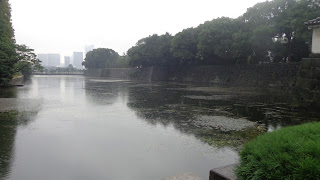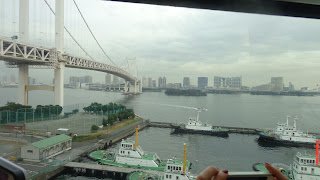How do I get to hunt and fish whenever I want and spend money on hunting trips all over North America? It is really quite simple. My wife likes to travel to faraway and exotic places in the world and this year I planned a trip to Japan through our favorite tour company, Odesseys Unlimited. What an exciting experience as we traveled by tour bus, trains and rode the bullet train several times. We liked that.
The trip lasted 14 days and we visited a total of nine cities and towns, some located in the mountains. The seacoast surrounding the island is where the majority of the population lives and it was in some of these cities that the bombing during WWII took place. In these cities the buildings all look new and have earth quake protection on the outside of the sky scrapers When we traveled into the towns in the mountains, they were untouched by the war and we saw and felt the Japan of decades ago.
I have never seen so many beautiful and well maintained buildings. Notice the support structure up the side of the building.
The first thing we noticed was how clean the cities were. This was absolutely amazing and we never saw a scrap of paper anywhere or a cigarette butt(s) all over the sidewalks and streets. Greenery was along the streets and sidewalks all trimmed and maintained as if we were in a garden. Civility was very prevalent by the population and this is something we are not used to in our country. The cleanliness and civility of the population is the result, I was told, of the Shinto religion observed by 80% of the Japanese population. Besides being very civil, the population was well dressed and groomed unlike much of our population we have in our cities. The police seemed to be non existent as we did not see any and took note of this fact.
Tokyo is a vast metropolis compromising 23 wards and 26 cities with a population of over 13 million residents, and 844 square miles. It is also the center of the Greater Tokyo Area, which has a population of more than 35 million, the most populous metropolitan area in the world.
We started out our excursion in Ancient Tokyo at the famed Meiji Shrine, a peaceful enclave of temples and gardens dedicated to the late 19th century Emperor Meiji and his wife. Built in traditional Shinto style with low wooden buildings surrounded by square courtyards, the shrine is one of Tokyo's most popular attractions.
Entrance into the Shrine and courtyards
Rice wine barrels
Gardens were everywhere with beautiful flowers, Chrysanthemums
Shinto wedding. Notice the bride in the background.
Notice the smoke in the background in from of the temple. The shopping arcade is located along and parallel to the buildings.
Buddhist temple
It was hard to get up to the smoke to make ourselves more healthy.
Young ladies dressed in traditional Japanese attire. Notice the phones.
The ladies were everywhere.
After almost a full day of touring we headed back to the hotel. We were still feeling the affects of the plane trip over and needed a nap before dinner. There was more exploration to do. Our entire group commented on the people and how courteous they were. Everyone has respect for the other person and no one was rude, crude, ill mannered or ill tempered like it is in our country. This was a refreshing experience.
We visited a park in downtown Tokyo and observed the beginning of a wedding ceremony.
This building was where our hotel was located starting on the 26th floor. Wherever we went we always kept track of that shape so we could find our way back.
We visited the Imperial Palace District. Surrounded by moats and ramparts the palace is home of the Imperial Family. Called Kokyo, the huge complex dates to the 15th century, when territorial disputes required massive fortifications and complex societal norms demanded elaborate palaces to reflect the high positions of the feudal lords. When completed, the Imperial Palace was the largest district in the world. From the lovely East and Outer gardens we saw the ruins of massive moat and walls that remain.
Moat surrounding the palace grounds. The constant rains on that day spoiled picture opportunities.
Gardens on the palace grounds.
Neatly trimmed trees and gardens were everywhere. The Japanese are master gardeners.
This lady is recognized all over the world for her talent.
The artist's assistant in front of some of the artist's works.
That afternoon was free time and the ladies wanted to go shopping. This was an experience out of the 1950's. There were very well dressed clerks there to help us with anything we wanted at each department of the store. This was a first class department store. Plus all of these young ladies were very pretty and well dressed. The ladies on our tour had a great time in the store and the guys just wandered around in amazement. This was shopping like I used to see in the big department stores in our home cities when I was a little boy. The employees were there to help you whether you could speak the language or not.
Back near the hotel was a tram that circled Tokyo bay. All information and signs were totally in Japanese and the train or tram was totally automatic. You bought a ticket to where you wanted to go and then slid it into a machine that collected the ticket. That let you on, then when you got off at the stop you had purchased, you slid the ticket back into another machine, and it ate it. In other words you were done.
My wife and I were standing there trying to figure things out. I wanted to go, but my wife said we would get ourselves lost. Actually, this was not a problem because we carried a card with the name and address of the hotel on us, so if that happened, we could show a cab driver and he would take us to the hotel. We did not worry about getting robbed or rolled. This is Japan, and you could go out on the streets after dark.
The assistant guide for the group happened along and helped us purchase the ticket and told us at which station to get off. We went out along the harbor of Tokyo bay and circled back to our starting point.
Tokyo Bay from the Tram.
More of Tokyo Bay.
Looking forward out the front window of the Tram. There are no operators and it is all completely automatic. You have to know what you are doing to ride it. Fortunately for us, our assistant guide came along who could speak fluent English and helped us along the way.
Click on the link and buy my book either in hard cover, soft cover or E-book.
Good hunting, good fishing, and good luck. Hank



























.jpg)